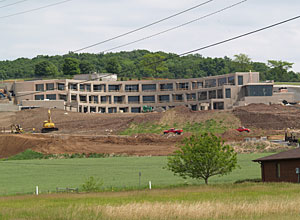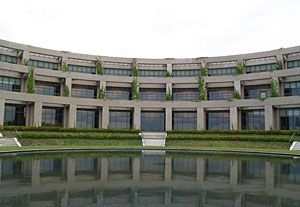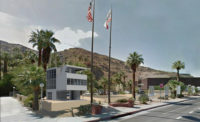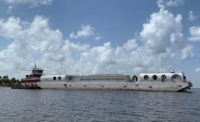Burrowed 50 feet into a hillside near Washington, D.C., a once secret, nuclear-blast-proof Cold War bunker that held billions in cash officially re-opened today as a showcase for the world’s largest collection of moving images and sound recordings. BAR Architects and SmithGroup have overseen the transformation of this former Federal Reserve Bank facility into the new National Audio-Visual Conservation Center for the Library of Congress.



Photos © Barbara J. Saffir
Burrowed 50 feet into a mountain near Washington, D.C., a once secret, nuclear-blast-proof bunker has been transformed into the Library of Congress’s new National Audio-Visual Conservation Center. The facility, seen here during construction, opened today (top). A team of designers and engineers from BAR Architects and SmithGroup added a three-story window all along the bunker’s main elevation to help infuse interior spaces with daylight (middle). Public spaces, including the building’s lobby, are located closest to the window wall (above). Openings cut into the former bunker’s concrete, blast-proof walls allow daylight to penetrate deeper into the building (right).
The nonprofit Packard Humanities Institute purchased the decommissioned bank bunker at Mount Pony in Culpeper, Va., for $5.6 million in 1998 and then funded its $155 million transformation, donating the facility to Congress last week—the largest gift ever made to the legislative branch. The 415,000-square-foot complex now provides space for preserving 6 million items from the library’s Motion Picture, Broadcasting and Recorded Sound Division. These items were previously scattered throughout seven locations nationwide.
BAR’s Earl Wilson says that one of the key design challenges was ensuring that librarians and conservationists have access to daylight. Although 80 percent of the structure is below grade, the designers located “people spaces” near a curving, three-story-tall window along the building’s rear elevation, opposite the main entry. Openings punched into the 16- to 18-inch-thick concrete, blast-proof interior walls help channel natural light into the inner rooms.
Three linked buildings comprise the 45-acre complex. The main structure contains 187,000 square feet of audio and video processing areas, offices, and specialized workrooms for digitalizing recordings from older media such as cassette tapes and vinyl records. It also includes public spaces such as a 208-seat theater, which will be open for occasional film screenings. At the lowest level of the four-story complex, a Collections Building contains low-humidity refrigerated vaults for storing original recordings. Classic films, old newsreels, rock music, and show tunes share the shelves with TV commercials and X-rated flicks. These collections even include the world’s oldest surviving moving image—Thomas Edison’s 1893 film of a person sneezing—and, fittingly, the Cold War classic Dr. Strangelove.
At the opposite end of this lowest level sit 124 metal-clad vaults for storing highly flammable nitrate film reels. When the architects first inspected this section before it was gutted and rebuilt, they found papers and other personal items lying untouched on the 1960s-era desks. “It looked dismal and depressing,” says Hal Davis, of SmithGroup’s Washington office. “It was an eerie sight, a twilight zone.” Perhaps the eeriest thing of all, though, was a cache of body bags—preparations for a nuclear war that, thankfully, never happened.






Post a comment to this article
Report Abusive Comment